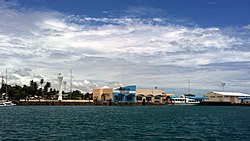San Carlos, Negros Occidental
Apariencia
San Carlos | |
|---|---|
Ciudad | |
 | |
 Mapa de Negros Occidental con San Carlos resaltado | |
 | |
| Coordenadas: 10°29'34.57"N, 123°24'34.04"E | |
| Nación | Filipinas |
| Región | Visayas Occidental (Región VI) |
| Provincia | Negros Occidental |
| Número de barangay | 18 |
| Fundación | 1898 |
| Gobierno | |
| • Type | ayuntamiento |
| • Electorado | Error en la secuencia de órdenes: la función «getValue» no existe. votantes (9 Mayo 2022) |
| Superficie | |
| • Total | 451,50 km2 (174,33 sq mi) |
| Elevation | 456 m (1496 ft) |
| Populación (1 Mayo 2020) | |
| • Total | 132,650 |
| • Densidad | 0,29/km2 (0,76/sq mi) |
| • Hogares | 33,623 |
| Economía | |
| • Clase de ingresos | el segunda clase clase de ciudad |
| • Incidencia de la pobreza | Error en la secuencia de órdenes: la función «getValue» no existe.% (Error: fecha y hora no válidas.)[2] |
| • Ingresos | ₱ <strong4a4df3e5">Error (Error: fecha y hora no válidas.) |
| • Activos | ₱ <strong4a4df3e5">Error (Error: fecha y hora no válidas.) |
| • Pasivos | ₱ <strong4a4df3e5">Error (Error: fecha y hora no válidas.) |
| • Gastos | ₱ <strong4a4df3e5">Error (Error: fecha y hora no válidas.) |
| Huso horario | UTC+8 (PST) |
| Código postal | 6127 |
| PSGC | |
| Código telefonico | 34 |
| Lenguaje nativo | Hiligueino Cebuano Tagalog |
| Website | http://www.sancarloscity.gov.ph |
San Carlos el segunda clase clase de ciudad na provincia de Negros Occidental, Filipinas. Tiene este zona de 451.50 kilometro cuadrado.
Comporme del 1 Mayo 2020 censo este tiene papulidad de 132,650 personas y 33,623 hogares. El designada codigo postal 6127 y PSGC 064524000.
Barangay
[revisa | revisa codigo]
|
|
Demografía
[revisa | revisa codigo]| Año | Populación | ±% p.a. |
|---|---|---|
| 1903 | 9749 | — |
| 1918 | 42 453 | +10.31% |
| 1939 | 69 990 | +2.41% |
| 1948 | 92 250 | +3.12% |
| 1960 | 124 756 | +2.55% |
| 1970 | 90 058 | −3.20% |
| 1975 | 90 982 | +0.20% |
| 1980 | 91 627 | +0.14% |
| 1990 | 105 713 | +1.44% |
| 1995 | 101 429 | −0.77% |
| 2000 | 118 259 | +3.35% |
| 2007 | 129 809 | +1.29% |
| 2010 | 129 981 | +0.05% |
| 2015 | 132 536 | +0.37% |
| 2020 | 132 650 | +0.02% |
| Ref: Autoridad de Estadísticas de Filipinas[3][4][5][6] | ||
Referencias
[revisa | revisa codigo]- ↑ «Province:». PSGC Interactive. Quezon City, Philippines: Philippine Statistics Authority. Consultado el Diciembre 17, 2016.
- ↑ «PSA Releases the 2021 City and Municipal Level Poverty Estimates» (2 Abril 2024).
- ↑ Census of Population (2015). "Region VI (Western Visayas)". Total Population by Province, City, Municipality and Barangay. Philippine Statistics Authority.
- ↑ Census of Population and Housing (2010). "Region VI (Western Visayas)". Total Population by Province, City, Municipality and Barangay. NSO.
- ↑ Censuses of Population (1903–2007). "Region VI (Western Visayas)". Table 1. Population Enumerated in Various Censuses by Province/Highly Urbanized City: 1903 to 2007. NSO.
- ↑ «Province of». Municipality Population Data. Local Water Utilities Administration Research Division. Consultado el Diciembre 17, 2016.
Enlaces externos
[revisa | revisa codigo]- PhilAtlas.com
- Philippine Standard Geographic Code
- Local Governance Performance Management System
- www
.sancarloscity .gov .ph
| Bangued (cabecera) | |
| Municipalidad: | Binalbagan ▪ Calatrava ▪ Candoní ▪ Cauayan ▪ Enrique B. Magalona ▪ Hinigaran ▪ Hinoba-an ▪ Ilog ▪ Isabela ▪ La Castellana ▪ Manapla ▪ Moises Padilla ▪ Murcia ▪ Pontevedra ▪ Pulupandan ▪ Salvador Benedicto ▪ San Enrique ▪ Toboso ▪ Valladolid |
| Ciudad: | Bacolod ▪ Bago ▪ Cadiz ▪ Escalante ▪ Himamaylan ▪ Kabankalan ▪ La Carlota ▪ Sagay ▪ San Carlos ▪ Silay ▪ Sipalay ▪ Talisay ▪ Victorias |
